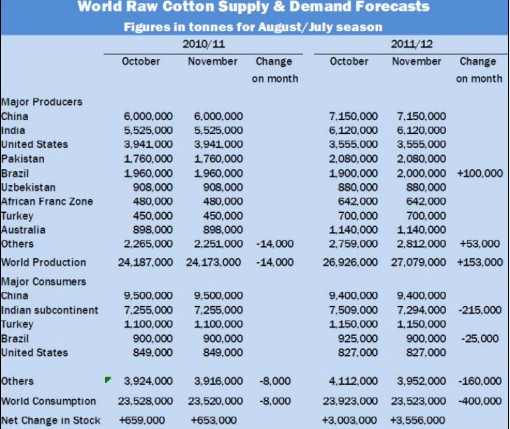|
The trend for European clothing groups to ditch local suppliers in favour of low-cost Asian imports has been around for some time. If price rises are sustained, as many expect they will, these increases will eventually have to be passed on to customers. This is likely to be exacerbated by the weakness of sterling, so retailers can either choose to have their margins squeezed or pass the costs on. Cotton consumption is expected to rise 2.8pc this year, but so-called "world ending stocks" are expected to fall by 2.6m bales to 50.1m bales. These are primary stocks of a commodity that are held in warehouses at midnight on the last day of each month. Increasing demand and falling supplies generally means just one thing ?? prices will continue to head higher. In China, cotton futures hit an all-time high last week because of tight supply and low stockpiles. Prices are up more than 7pc in two weeks and a supply deficit is expected to last throughout the year. "Shrinking inventories and this year's adverse weather are the main reasons behind the supply shortage, which may expand further until September when sales of this year's cotton begin," according to Wang Yong, an analyst at Hongyuan Futures in Beijing. A significant amount of the Chinese cotton crop has failed. The China Cotton Association said that heavy snowfall in Xinjiang Uygur, the major cotton-producing area of the country, has led to replanting. China's textile industry is the world's largest consumer of cotton. According to the US Department of Agriculture (USDA), Chinese cotton consumption is expected to jump by 1.5m bales in the 2010-2011 season to 49m bales. The USDA forecasts that China will import 2.18m tonnes of cotton this year, up from 1.52m tonnes last year. Next year, imports are expected to rise to 2.5m tonnes to meet demand from its textile industry. In Pakistan, not only is cotton supply tight, but the Pakistan Textile Exporters Association (PTEA) wants caps placed on the exports of cotton yarn. This is because cloth exports have been falling and the PTEA wants the "value added" side of the business to remain in Pakistan. Cloth exports have slumped 11pc between July and April. India put an outright ban on cotton exports last month, as local prices rocketed. These were eased on Friday, but any exports will have to be under licence. The ban reduced the supply pressure in India, with prices falling 20pc since the ban was implement on April 19. However, despite this fall, prices are still one third higher than at this time last year. About 60pc of India's exports go to China, so the reversal of the ban should help ease the situation there, but prices are likely to rise in India as a result and the ban could be implemented again. The supply situation is expected to ease next year as more cotton is planted, but prices are likely to remain stubbornly high. According to China's National Development and Reform Commission, global cotton production will increase "on a large scale" in the year starting September 1, which will cause cotton prices to "stabilise at the current high level". Cotton futures in the US are not yet close to the all-time highs seen in 2008, but investors are still betting on price rises. According to the latest Commitment of Traders reports from the US Commodity Futures Trading Commission data, long positions outnumbered short positions by 32,603 contracts on ICE Futures in New York in the week ending May 11. However, the net long position is shrinking ?C down by 7,795 contracts, or 19pc, week-on-week. US cotton is not at a record high because countries such as China have import quotas. China has been forced to relax them this year to try and curb cotton inflation. Usually 1.89m tonnes is allowed through the border each year, but the government increased this by 800,000 tonnes earlier this month. This is a warning for investors wishing to ride the cotton boom. The easily tradable US futures contracts are not necessarily going to continue to rise. The shortage is in the clothing manufacturing areas of the world and that's where prices are highest. Speculators such as hedge funds and banks have started to close their positions in the US. The US upside would come from China continuing to relax its import quotas. This is not very likely, so investors should beware. India has world's second doomsday vault India has established the world's second doomsday seed bank after a plague of locusts destroyed barley crops five years ago. |
|
Clothes prices to rise as cotton jumps
Updated: 2010-5-25 Source: Texglobe-ÐÅÏ¢ÖÐÐÄ

Recommended News
Photo Gallery
Most Popular



